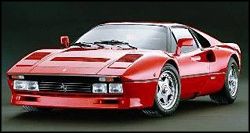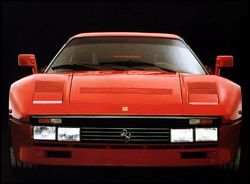 The
288 GTO (the "288" part of the name derived from the then
tradition of liters + cylinders 2.8 liters and 8 cylinders in this case) was
designed to raise the stakes in the supercar leagues. It was intended to
compete in the Group B division of motorsport (alongside the Porsche 959),
but to homologate the car 200 had to be built. The road-going examples of
this car set the pace for future super cars like the Cizeta Moroder V16T,
the Lamborghini Diablo and the Jaguar XJ220. Whilst externally bearing a
resemblance to the 308 GTB, the 288 GTO was in fact substantially
different. The front end is new with a spoiler which is more effective at
high speeds; the large rearview mirrors are to give better rear view
visibility and to meet the safety requirements in countries where the GTO
was exported.
The
288 GTO (the "288" part of the name derived from the then
tradition of liters + cylinders 2.8 liters and 8 cylinders in this case) was
designed to raise the stakes in the supercar leagues. It was intended to
compete in the Group B division of motorsport (alongside the Porsche 959),
but to homologate the car 200 had to be built. The road-going examples of
this car set the pace for future super cars like the Cizeta Moroder V16T,
the Lamborghini Diablo and the Jaguar XJ220. Whilst externally bearing a
resemblance to the 308 GTB, the 288 GTO was in fact substantially
different. The front end is new with a spoiler which is more effective at
high speeds; the large rearview mirrors are to give better rear view
visibility and to meet the safety requirements in countries where the GTO
was exported.


Numerous air intakes were scattered around, each with its each own precise function. Weight reduction was applied by using the same Formula One technologies as used on the Ferrari 126 C4 F1. The bodywork was designed by Pininfarina (as was the 308 GTB) but crafted with extensive use of glass-fiber and composite materials, and was slightly longer than the 308, with a corresponding increase in wheelbase. Amongst the generally dry eighties designs, the supreme mastery of Pininfarina had produced an elegant and purposeful body for a modern classic. Without losing any of the proportions and balance of the acclaimed 308, Pininfarina had managed to stretch the wheelbase a full 110 mm. It was a welcome breath of fresh air in the staleness of eighties design doldrums.

The engine remained just in front of the rear axle, but was rotated through 90 degrees to end up longitudinally aligned. Placed lower in the chassis than in the 308, it allowed for a lower center of gravity, improving the already good handling characteristics. The new engine was slightly de-bored (from 81.0mm to 80.0mm) to allow for turbo charging without changing its categorization in terms of capacity.
 Unfortunately,
its racing intentions were not realized. By the time the 288 GTO
Evoluzione was developed as the race version of the car the FISA had
decided to stop the Group B class. In the end there were 272 GTO's made
and only five Evoluzione's with very few GTO's actually competing in any
form of racing. Collectors, however, snapped them up and Ferrari had no
trouble moving their stock. The GTO's great competitor in terms of
performance and image was the Porsche 959. It too was conceived as a
weapon in Group B, although it saw a bit more racing than the GTO. Whilst
their ambitions may have been similar, their methods certainly were not.
The 959 had 4-wheel drive and all manner of electronic controls, a very
much plusher interior and a number of driving aids. Ferrari's GTO had a
spartan interior, rear-wheel drive only and very little in the way of
luxury. The only two interior options were electric windows and air
conditioning. It was, in the finest Ferrari tradition, a car to be driven.
When the GTO was introduced it was the fastest and most powerful
production car ever.
Unfortunately,
its racing intentions were not realized. By the time the 288 GTO
Evoluzione was developed as the race version of the car the FISA had
decided to stop the Group B class. In the end there were 272 GTO's made
and only five Evoluzione's with very few GTO's actually competing in any
form of racing. Collectors, however, snapped them up and Ferrari had no
trouble moving their stock. The GTO's great competitor in terms of
performance and image was the Porsche 959. It too was conceived as a
weapon in Group B, although it saw a bit more racing than the GTO. Whilst
their ambitions may have been similar, their methods certainly were not.
The 959 had 4-wheel drive and all manner of electronic controls, a very
much plusher interior and a number of driving aids. Ferrari's GTO had a
spartan interior, rear-wheel drive only and very little in the way of
luxury. The only two interior options were electric windows and air
conditioning. It was, in the finest Ferrari tradition, a car to be driven.
When the GTO was introduced it was the fastest and most powerful
production car ever.
Request for quote